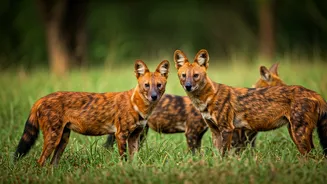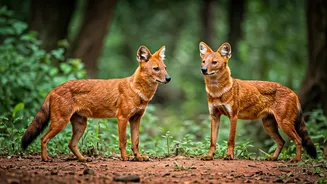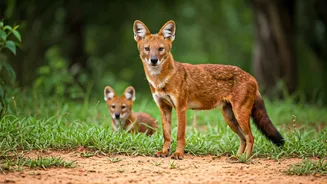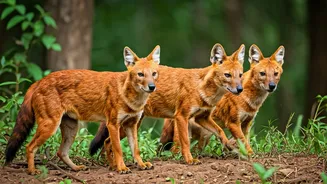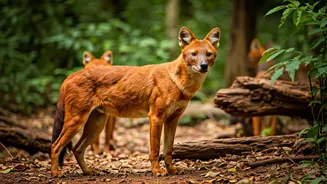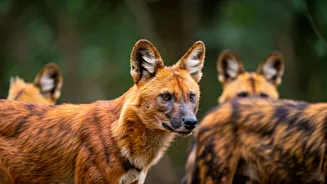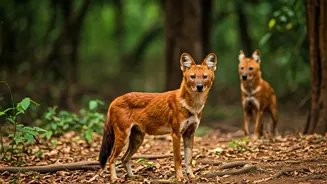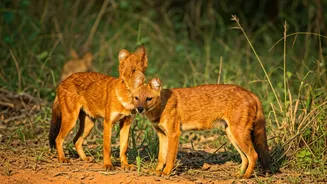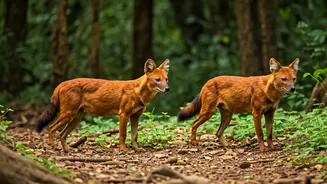Introduction: Dholes' Haven
The five national parks highlighted in this piece each provide crucial habitats for endangered wild dogs, offering a glimpse into India's remarkable biodiversity.
These parks are not just scenic locations; they play a significant role in conserving these wild canids. The presence of dholes in these regions underscores the urgent need to conserve their habitats and maintain ecological balance. Visitors to these parks contribute to conservation efforts while experiencing the beauty of India's natural heritage. Understanding the importance of protecting these areas is key to ensuring that future generations can witness the splendor of dholes and their ecosystems.
1. Kanha National Park
Kanha National Park, located in Madhya Pradesh, is a cornerstone of tiger and dhole conservation in India. Known for its rich flora and fauna, this park is an excellent place to spot dholes and other wildlife. Kanha's varied terrain, from dense forests to grassy meadows, supports a thriving ecosystem, making it an ideal habitat for these wild dogs. The park's management has implemented various conservation programs to protect dholes and their prey. Kanha National Park also provides guided tours and wildlife safaris, giving visitors a chance to learn about these amazing creatures. Its commitment to preserving biodiversity has made it a model for other national parks.
2. Tadoba-Andhari Tiger Reserve
The Tadoba-Andhari Tiger Reserve in Maharashtra presents another opportunity to witness the elusive dhole. This reserve is known for its high tiger population and is also home to a healthy number of dholes. The park’s diverse habitats, like dense forests and water bodies, create an optimal living environment for dholes. Tadoba-Andhari Tiger Reserve has implemented several conservation programs aimed at protecting dholes from habitat loss and human interference. The reserve's commitment to protecting the environment enables tourists to experience the magnificence of the region's wildlife, which enhances their appreciation for conservation efforts. This reserve serves as a reminder of the need to protect the nation's natural resources.
3. Bandhavgarh National Park
Bandhavgarh National Park, also located in Madhya Pradesh, is famed for its high density of tigers, and also serves as a refuge for the endangered dhole. The park’s hilly terrain and dense forests provide a safe sanctuary for dholes. Bandhavgarh’s conservation efforts focus on habitat preservation and reducing human-wildlife conflict. The park promotes sustainable tourism, ensuring that visitors learn about conservation and the importance of safeguarding wildlife. The park offers an opportunity to study the behaviors of these endangered canines and the many different ways they communicate with each other. This park contributes to the protection of India’s biodiversity and promotes the importance of sustainable tourism.
4. Periyar National Park
Periyar National Park in Kerala provides an opportunity to view dholes in the southern region of India. The park, famous for its elephants and tigers, also supports a population of dholes. The diverse ecosystem of Periyar, including forests and the Periyar Lake, provides a perfect habitat for these animals. Periyar’s conservation strategies include monitoring dhole populations and protecting their habitats from poaching and deforestation. The park also provides educational programs and promotes eco-tourism to increase public understanding of wildlife preservation. This park is an integral part of India’s ecological system and serves as a prime example of successful conservation initiatives.
5. Ranthambore National Park
Ranthambore National Park in Rajasthan, known for its tiger population, also offers opportunities to spot dholes. This park’s dry deciduous forests and rocky terrain provide an exceptional habitat for dholes. Ranthambore has implemented various conservation strategies, including habitat restoration and anti-poaching measures, to protect the dholes. Visitors to Ranthambore can experience the park's rich biodiversity and witness the efforts being made to conserve its wildlife. This park highlights the dedication of wildlife authorities and conservationists in protecting these endangered species and their habitats, emphasizing the importance of ongoing conservation efforts across India.


